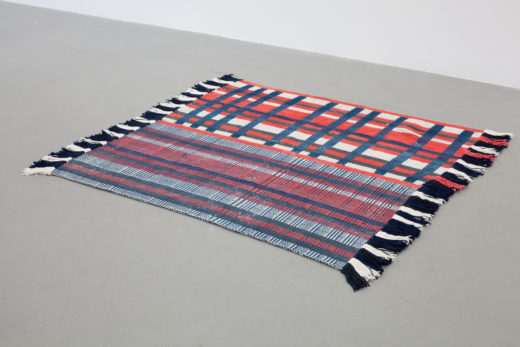A Thread of Execution
Erin Thurlow
 Diedrick Brackens, a chance to move up, 2017. Woven cotton. 64 1/2 x 48 inches, Courtesy Steve Turner
Diedrick Brackens, a chance to move up, 2017. Woven cotton. 64 1/2 x 48 inches, Courtesy Steve Turner
Dimensions Variable
October 20 – December 29, 2017
The loom was the original disruptive technology of the modern era and its technical relationship to early computers is often remarked upon. Computational devices inherited textile production’s programmable punch-card “reading” systems which control mechanical behaviors in an attempt to produce uniform outcomes. Digital software has vastly improved on this of course, but variation in the form of artifacts and distortion still inhabit the copy, especially once materiality is brought to bear. The work of Margo Wolowiec (Catch Up/1983, 2017) exploits and magnifies this condition by reworking printed digital images through a deconstructive process of weaving. Although the final work has a clear relationship to photography, any imagery is unrecognizable.
Lying like a rug on the floor (or a Carl Andre sculpture) Deidrick Bracken’s, a chance to move up, 2017, nevertheless reads like a hard-edge abstract grid painting, if not a pretty doormat. The bolder pattern on one half appear to hover closer, a blown-up version of the other side. It’s a way we have become accustomed to seeing information displayed in the digital era (“Enhance.”), and the reference to layered levels of coding is easy to visualize in the interwoven bands of color.
The look of the show and much of the art is post-minimal, a style of art that has come to weigh on the organizing strategies of most contemporary artistic and curatorial practice, but is in fact historically associated with the emergence of feminist art practices and the introduction of soft materials in opposition to their hard, minimalist predecessors. The inclusion of Elaine Reichek, who has contributed an embroidered suite of four serialized, sample-sized Bridgett Riley’s, each in a different color (Riley 1-4, 2007) bears this out. Reichek’s practice, which began in the seventies, was a critique/homage aimed at the male-dominated Ab-Ex and minimalist schools that preceded her. Her work here has a secondary link in Riley’s Op-Art reference to the rapidly developing computer-aided imaging technologies that were drastically reorienting aesthetic priorities of her time. These kinds of associative thematic layers are woven thoughout the show.
Laura Marsh’s work harkens back to a more homespun civility than exists on most online forums. A woven and embroidered text piece, Dear Americans it’s Time, 2017, is a material echo of the online meme, but its imploringly friendly political content is simultaneously sentimental and ironic, the post 9/11 version of sincerity.
If computing inherits much of textiles’ structural underpinning, what differentiates it is another metaphorical tapestry, the network, the non-visible fabric that links the software running on millions of separate machines, whose historical analogy is the rigid structure of commodities and trade, or capitalism. While several artists in the show use some degree of electronic or digital processes as part of their work, it is puzzling that no inverse artworks by software designers, web artists or others who work primarily in digital technologies was included in the show. It’s a curatorial decision that makes the comparison feel one-sided and as though a claim was being laid by the old order on recent developments. This claim is warranted, but the other side would surely have something interesting to say about it.
Erin Thurlow is an artist and writer based in Miami. He is the Reviews Editor of The Miami Rail.










